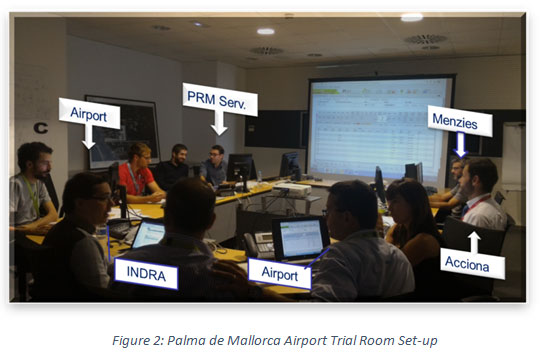SESAR 2020 members recently completed tests showing how better monitoring of baggage and passenger information can improve the predictability of departure times at airports. The project, entitled “total airport management” (TAM) aims to show how the holistic monitoring of key airport processes, notably aircraft, passengers and baggage, are key to increasing the performance of individual airports as well as the network as a whole.
The time an aircraft remains at an airport, from landing until its departure to a new destination, is a critical parameter in airlines’ planning strategies. More and more airlines insert flight time buffers in their fleet planning to cope with airborne delays, such as arrival holdings and flow control regulations, in order to meet passengers’ arrival expectations.
The pressure is now placed on the ground processes. Increasingly airports are expected to find ways to reduce the turn-around times, the time the aircraft is at its parking stand, to a minimum in order to stay competitive. However, this can be challenging given the growing complexity of certain landside processes:
- Increased passenger security screening and passport control requirements demand extra resources to avoid queue delays;
- Stricter bag security and tracking regulations require extra complexity in bag management systems;
- The “cost-free” policy to improve the quality of service provided to passengers with reduced mobility (PRMs) has created a growing demand in this specialised service with a consequential impact on passenger boarding/deboarding times.
There is therefore an urgent need to apply measures to mitigate the impact of these processes on aircraft ground times. That is why airport stakeholders are turning to solutions to better monitor and manage such processes.
In June 2015, SESAR members conducted tests at Palma Airport to assess the impact of the passenger process within the overall aircraft turnaround process. The objective was to predict as early as possible the potential late arrival of passengers at the boarding gate. This prediction is an important element in the approach to turnaround management as the “synchronisation” between passengers arriving on time at the gate and the aircraft readiness is a key driver of on-time performance. Passenger queue and transit time monitoring from the security screening area to the boarding gate was used to inform airlines of expected passenger “Time at Gate”.
The important results obtained in delay reduction, encouraged Palma Airport stakeholders to extend landside process monitoring to address two remaining key airport processes: the baggage management and PRM processes.
During October 2017, SESAR 2020 members assessed how these two new processes could be enhanced and included in the landside process:
- For the PRM, a target start of boarding time (TSBT) was determined. This parameter was determined as a function of the expected time that the aircraft would be ready to accept a push-back clearance, the type of stand facility (contact or remote), as well as the number and type of PRMs. This information was then shared with both the handling agents and PRM service, to ensure early presence of all PRMs at the gate, in such a way that the TSBT could be respected. The use of TSBT, well received by the PRM service provider, has highly improved the PRM priority service delivery as compared with the current way of working.
- For baggage management, increased situational awareness was obtained by complete baggage tracking throughout the baggage handling system (BHS). Baggage handlers were thereby provided with information on baggage carrousel situation as well as more accurate information on the expected aircraft arrival time at the stand. This information was intended to be integrated into the current handlers’ operational systems thereby avoiding the need for additional complex IT deployment. .
The resulting solution, ‘enhanced airport collaborative performance monitoring’ will therefore cover both passengers and baggage processes - to improve the predictability of the departure estimated times. The aim is to provide a holistic monitoring of key airport processes notably aircraft, passengers and baggage so as to ensure the maximum degree of synchronisation between them and to benefit network performance by providing the Network Manager with high levels of predictability in relation to departure flights.
Read more about total airport management:
Interview with Florian Guillermet, Business Airport
Getting to grips with airport operations management
Find out more about the project and partners

